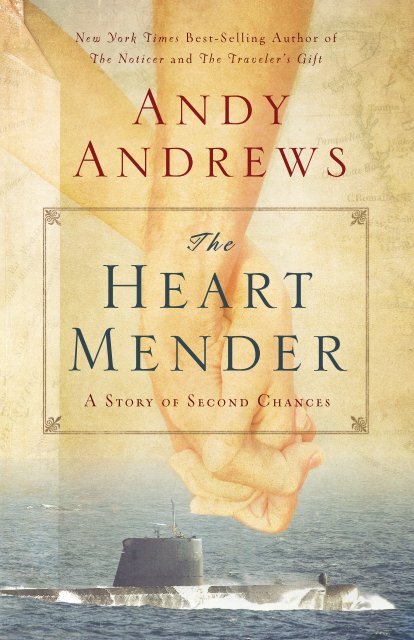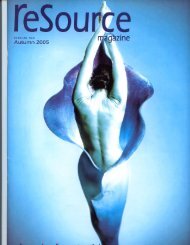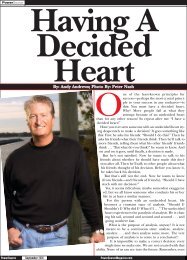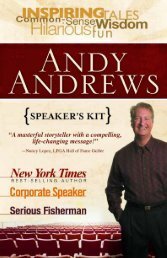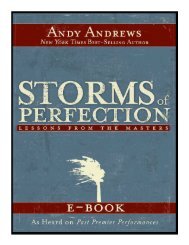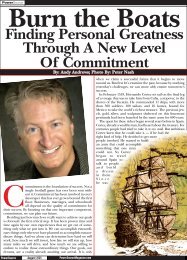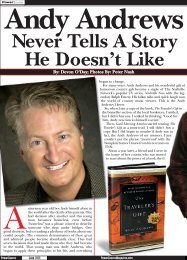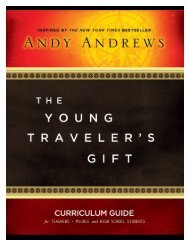00-01.The Heart Mender - Andy Andrews
00-01.The Heart Mender - Andy Andrews
00-01.The Heart Mender - Andy Andrews
You also want an ePaper? Increase the reach of your titles
YUMPU automatically turns print PDFs into web optimized ePapers that Google loves.
N e w Y o r k T i m e s B e s t - S e l l i n g A u t h o r o fT h e N o t i c e r a n d T h e T r a v e l e r ’ s G i f t<strong>Andy</strong><strong>Andrews</strong>T h e<strong>Heart</strong><strong>Mender</strong>A S t o ry o f S e c o n d C h a n c e s
“With the skill of a virtuoso, <strong>Andy</strong> <strong>Andrews</strong> continues his stringof successful writing performances in The <strong>Heart</strong> <strong>Mender</strong>, his latestentertaining masterpiece. The plot, characters, and storyline combineto summon the reader into an unforgettable experience.”—Robert SilversExecutive Publisher, The Saturday Evening Post“At the Maui Writers Conference, we have had the best in thecountry, including filmmakers Ron Howard and James L. Brooks,Pulitzer winners Wendy Wasserstein, Dave Barry, Jimmy Breslin,and Carl Bernstein, best-selling authors Elmore Leonard, MitchAlbom, Robin Cook, Tony Hillerman, John Saul, ElizabethGeorge, Barbara Kingsolver, and others. <strong>Andy</strong> <strong>Andrews</strong> is right atthe top of the list. He is mesmerizing, funny, captivating, heartwarming,and just plain ol’ good. To have one of his books onyour shelf brings his hope-inspiring wisdom into your home.”—Shannon TulliusCofounder & Director, Maui Writers Conference“The <strong>Heart</strong> <strong>Mender</strong> is a sweeping adventure filled with many emotions.The compelling narrative unites the past and present in afantastic must-read!”—Bonnie TiegelSenior Supervising Producer, Entertainment Tonight/The Insider“The principle woven into this incredible story has changed my life.”—Tim BrandoCBS Sports Host & Commentator“If life had a ‘reset button’—The <strong>Heart</strong> <strong>Mender</strong> would be it.”—Joseph FarahEditor and CEO, WorldNetDaily.com
Other Books by <strong>Andy</strong> <strong>Andrews</strong>SThe Traveler’s GiftThe Young Traveler’s GiftThe Lost ChoiceMastering the Seven DecisionsSocks for ChristmasReturn to Sawyerton SpringsThe Butterfly EffectThe Noticer
The<strong>Heart</strong><strong>Mender</strong>A STORY OF S ECOND C HANCES<strong>Andy</strong><strong>Andrews</strong>
To the Stimpson familyof Mobile, Alabama.S© 2<strong>00</strong>5, 2010 by <strong>Andy</strong> <strong>Andrews</strong>All rights reserved. No portion of this book may be reproduced, stored in a retrieval system,or transmitted in any form or by any means—electronic, mechanical, photocopy, recording,scanning, or other—except for brief quotations in critical reviews or articles, without the priorwritten permission of the publisher.Published in Nashville, Tennessee, by Thomas Nelson. Thomas Nelson is a registered trademarkof Thomas Nelson, Inc.Previously published as Island of Saints (ISBN 978-0-7852-6140-7).Thomas Nelson, Inc., titles may be purchased in bulk for educational, business,fund-raising, or sales promotional use. For information, please e-mailSpecialMarkets@ThomasNelson.com.Interior photos: Jared McDaniel, Studio430.comLibrary of Congress Cataloging-in-Publication Data<strong>Andrews</strong>, <strong>Andy</strong>, 1959–The heart mender : a story of second chances / <strong>Andy</strong> <strong>Andrews</strong>.p. cm.ISBN 978-0-7852-3103-5I. Title.PS3601.N5525H43 2010813'.6—dc222<strong>00</strong>9052644Printed in the United States of America10 11 12 13 14 WC 6 5 4 3 2 1
Author’s NoteTHE BOOK YOU ARE HOLDING IN YOUR HANDS HAS GENERATEDmore questions than any work I have ever produced.Therefore, in an effort to satisfy what might become anoverwhelming curiosity, maybe it is best that I address thosequestions for you now—before you begin to read!I am often asked if I have a favorite among the books Ihave written. Yes, I do. And this is it. The <strong>Heart</strong> <strong>Mender</strong> isnot only what I believe to be my best work, it is the mostcompelling—bringing all aspects of a mystery, love story,and thriller to the table in order to deliver a life-changingprinciple.What is my greatest career disappointment? Again, Iwould answer, “This manuscript you hold in your hands.”Not this title—just the manuscript. You see, the manuscriptwas previously published under another name—Island ofSaints—and for the most part barely even saw a bookstore!Through issues of bad timing, little previous success of myown, and zero publicity, the book was quickly forgotten.The few people who did find the book, however, became(and remain) extremely vocal about their love for the storyand its power. Soon a movie producer found it, and the ball,which had seemed lost in deep weeds, started rolling again.Now released with a more appropriate title, the backingv
of a happy publishing company, and a few rabid supporterswho still call this their favorite book, The <strong>Heart</strong> <strong>Mender</strong> isready to go. And now there is only the biggest question ofall waiting to be answered . . .“Is this story true?”Without exception, every person who has read this bookhas asked that question.And the answer is . . . yes . . . for the most part. All thenumbers, the history, the dates, and the items I found arereal. I have changed some locations and most of the names.The principal characters do exist, but perhaps not in the specificmanner in which they are presented. Curiously, a few ofthe main characters’ experiences turned out to be more commonthan I had previously believed. When the first incarnationof this manuscript was produced, I received communicationfrom several families with proof that they, too, hadbegun their lives in this country with the very same kind ofhistory as that of my friends.At the end of this book (and don’t read ahead!) I decidedto add a “Where Are They Now?” section, which I thinkyou will enjoy. And before you ask . . . yes . . . for the mostpart, it will be true!<strong>Andy</strong> <strong>Andrews</strong>Orange Beach, Alabama
partone
Chapter 1IT IS EARLY SUMMER AS I SIT AT MY DESK AND FINALLYbegin the process of sorting what I know to be true fromwhat I merely suspect. As I form the words and type theminto record, I shall endeavor to separate facts from the legendand myth in which they have now been shrouded fordecades.As an author, I usually have a particular work living inmy head—complete with its title, plot, subplots, and ending—formonths before leaping, as fully formed as I canmake it, onto the page. At present, however, I haven’t evena working title for this manuscript. The book you are holding,if indeed it has come to that, was nothing I everintended to write. My next two books have been outlinedand are ready to begin, but I have become distracted by anattempt to solve a mystery literally thrust into my life by theearth itself. Let me explain . . .I live with my wife, Polly, and our two boys on a smallisland situated along the Florida/Alabama coastline of thenorthern Gulf of Mexico. There is a single, small bridge connectingus to the mainland. Orange Beach, Alabama, just toour west, is where we bank, vote, attend church, and shopfor groceries.3
4 <strong>Andy</strong> <strong>Andrews</strong>Perdido Key, Florida, is to the east. A thirty-second drivefrom the bridge in that direction crosses the Florida stateline and passes the world-renowned Flora-Bama Lounge, aloosely constructed conglomeration of wood, brick, and tentmaterial most famous, I suppose, for being famous.Therefore, it is always packed, and if the wind is right,sometimes late at night I can hear strains of “RedneckMother” or “You Don’t Have to Call Me Darlin’ . . .Darlin’” from my dock.Over the past twenty years, this previously ignoredcoastline has increasingly become a prime destination forsummer tourists and winter snowbirds drawn to the areaby the turquoise water and dazzling white sand. The beach,one of the few in the world to be composed of only one mineral—inthis case finely crushed quartz—is part of a onehundred-milestretch of beach that includes the Floridatowns Panama City and Destin and is known as the“Miracle Strip.”Our home is situated on a dune line that rises twenty-fivefeet from the water’s edge and runs east to west, affording aview of the water on both sides of the island. The landscapingis minimal at best. Here and there we’ve managed to coax afew flowers out of the sand, and several potted palms gracethe dock. Polly holds with the belief that “natural is better,”and I, having not forgotten the chores thrust upon me by mygarden-crazy parents, am happy to agree.So, instead of grass demanding to be mowed and azaleabushes begging to be fertilized or pruned or have pine strawplaced by hand around their precious roots, we have seaoats and wax myrtles and ancient oak trees growing in thesand. And they grow quite nicely without any help from me.Most of the time.
The <strong>Heart</strong> <strong>Mender</strong> 5Last September, I noticed the largest wax myrtle on ourproperty had begun to die. In the almost one hundred yearsof its existence, the tree had grown to well over forty feetand shaded an area the size of a tennis court. It crowned thetop of the dune near our kitchen porch, and boaters oftennoticed this magnificent monarch even before they saw thehouse. Because of its height and close proximity, my familywas keenly aware of the tree’s impending demise.By the new year, no semblance of life was left in itsbranches. I was surprised to find myself strangely relieved,as if an old friend had finally passed away after a strugglethat had become too difficult to witness. And after aproper period of what I called mourning and my wifetermed “yard work procrastination,” I knew it was time toremove the tree.The wax myrtle, also known as the southern bayberry,was used by the Indians and early American colonists tomake candles. Its distinctive, fragrant scent comes fromvolatile oils contained in tiny glands on the leaves. These oilsrender the tree highly flammable and remain in the tree longafter it dies. Dead wood infused with combustible resin isnot a good combination when it is located so near a house,and so it was with a heavy heart (and a portable radio tunedto the NFL play-offs) that I struck my first blow against thetrunk of the tree.I am an ax man. Ever since, as a teenager, I saw themovie in which a chainsaw was the weapon of choice, I’venever been especially keen on that particular sound. So,instead of a quick rip and a crash, it took until early afternoonto chop down the tree and haul its scattered piecesaway, leaving only the stump as a reminder that anythinghad been there at all. But as much as we loved the tree, no
6 <strong>Andy</strong> <strong>Andrews</strong>one wanted the reminder. “Dig it up,” my wife urged inwhat she felt was an encouraging voice, and I did.Granted, when surrounded by sand, a stump is not theformidable opponent it becomes when its roots have embeddedthemselves in clay or a rocky soil. There is, however,something to be said for a root system having spent a hundredyears in search of nourishment. Tremendous mats ofstringy, underground branches stretched in far larger networksthan their leafy counterparts had ever accomplishedin the sunshine. I was shocked and exhausted, I had a holein the ground the size of my grandfather’s Buick, and I wasstarting to think in regard to my dear wife, What she doesn’tknow won’t hurt her. I was about to reverse course and hidethe roots that were left by covering up the whole mess whenmy shovel struck something that didn’t feel like root.For a brief moment, the shovel stuck. It was as if I hadhit a monstrous wad of gum or taffy. And the sound was different.I had grown accustomed to the high-pitched swish ofthe steel shovel as it cut through the sand, but this tonereverberated as a dull thunk. At the time, I didn’t think itsounded like metal, but that’s exactly what it was.With the shovel’s retreat, I exposed a hand-sized portionof rusted . . . something. Sand poured into a slit in the objectthat had obviously been opened by the slicing of the shovel.On my hands and knees, I quickly pulled wads of tiny rootsaway from the item and, with my fingers, pried it loose. Itwas a can.I turned the heavily rusted object over in my hands,being especially careful not to cut myself on any of the sharpedges. It was large . . . like the gallon-sized cans a restaurantuses for vegetables or refills of ketchup. The can was sealedat both ends, but the rust, I noticed, had created several tiny
The <strong>Heart</strong> <strong>Mender</strong> 7holes in its surface in addition to the large one made by theshovel’s blow.The presence of the holes made it apparent that the canwas not filled with food or liquid of any kind, but still, itwas heavier than an empty can should feel. And itrattled when I turned it.Although I assumedthe clatter to becaused by shells andsand, I was curiousand pried apart thethin, fragile metal.Inside the can, dankand mildewed, waswhat I determined tobe an old chamois—once soft leather nowstiffened by age andthe rusty dampnessin which it had beenimprisoned. Pullingthe leather freefrom the can, Isaw that it had, at onetime, been carefully folded. Now, though, itwas shrunken somewhat, blackened by mold and almosthard on its edges like a big, ugly potholder that someone hadstarched.The leather folds came apart easily in my hands, and asthey did, a button fell out and onto the sand at my knees. Asilver button. Though somewhat tarnished, the face of thebutton was beautifully etched with an anchor. From its back
8 <strong>Andy</strong> <strong>Andrews</strong>extended a single loop surrounded by lettersso tiny that I was unable to make out anything morethan a K, an R, and on down the line of script, what Ithought might be an A.Placing the button on the kitchen porch behind me, Itugged harder at the leather from which it had come andtore a piece completely off. Three more buttons, identical to
The <strong>Heart</strong> <strong>Mender</strong> 9the first, along with a ring,fell into the sand. The ringwas also silver, a bit morediscolored than the buttons,and had as its centerpoint an eagle surroundedby a wreath. The ringalso had letters—thesemuch larger—which ranthe entire outside circumferenceof the circle.I read the wordsaloud: “Wir FahrenGegen Engelland.”Not being able to translate or even identify the language,I set the ring aside with the buttons and continued topeel apart the crusty leather. With the final layer laid open,I slowly set the chamois on the sand and gazed openmouthedat what it held. There were four more buttons,making a total of eight, a silver anchor badge about 2 inchestall by 1 1 ⁄2 inches wide, some kind of black-and-silver medalwith a bit of red, black, and white ribbon attached, andthree, only slightly water-damaged, black-and-white photographs.
10 <strong>Andy</strong> <strong>Andrews</strong>The first photograph wasa simple head and upper bodyshot of a man in militaryattire. I didn’t recognize theuniform, but saw immediatelythat the buttons in thepicture were the same ones Inow had in my possession.In fact, I counted them.Eight silver anchor buttonsin the photo . . . and eighton my porch. I reallycouldn’t tell if the man inthe picture was twenty orforty, and in that way, hereminded me of old picturesI have seen of collegekids in the nineteen thirties or forties. They all lookedyears older than they actually were.The man was not smiling. It was as if he was not entirelycomfortable with the idea of having a photograph made. Hewas not thin or fat, though “thick” might have been anaccurate description of his body type. The same eagle thatappeared on the ring was also on display on the right breastof his uniform jacket and the top of an odd, beret-type cap.Stitched in large, Gothic script along the lower brim of thecap was the word Kriegsmarine.The second photograph was smaller and had a decorativeblack border framing the print. In it were three figures: ayoung woman in what struck me as the best dress she owned,a man in a suit and white shirt with no tie, and a baby in awagon between them. Whether the child was a boy or girl, I
The <strong>Heart</strong> <strong>Mender</strong> 11couldn’t tell. Though the woman looked directly (fearfully?)into the camera, the man’s attention was focused toward thechild, causing his face to appear in profile. I wasn’t certain,but I thought that maybe he was the same uniformed man inthe previous photograph.It was the third photograph, in addition to the ribbonedmedal, that had my attention. The black-and-silver militarydecoration was cast in the shape of a cross. At the bottomleg of the cross was a date, 1939, and in its center a morefamiliar symbol. I blinked as I touched it with my finger andshivered, whether from the January chill or somethingunseen, I didn’t know.Quickly I looked again to the last photograph. Men on aboat of some sort . . . lined up as if for inspection. On theright corner of the front line, yes, there was the uniformedman from the first picture. Four officers in highly decoratedmilitary overcoats were in the foreground of the shot. Threewore dark clothing with what I imagined to be gold or silver
12 <strong>Andy</strong> <strong>Andrews</strong>trim. The fourth man, to the far left of the photograph, wasdressed immaculately in an outfit cut in the same design, butof a paler material. It was this man whose face I recognized.This was the man for whom the symbol on the medal hadbeen created. But why on earth was a picture of Adolf Hitlerburied in my backyard?
Chapter 2A WEEK LATER, I WAS STILL NO CLOSER TO ANSWERING MYquestion. Where had this stuff come from? At least theInternet, with its various search engines, had begun to fill insome of the blanks about what the actual pieces were. Andthe swastika embossed on the medal gave me some idea ofwhat I might find.After rushing inside and fanning out the items on thekitchen table for my astonished wife, I retreated to my officeand cranked up the computer. The first word I searched wasKriegsmarine, the script on the man’s hat in the first picture.I quickly found that it was the name of the German navycontrolled by the Nazi regime until 1945. Previously titledthe Reichsmarine, the Kriegsmarine was formed in May of1935 after Germany passed the “Law for the Reconstructionof the National Defense Force.” This law brought back intoexistence a German military presence that had been essentiallybanned by the Treaty of Versailles at the end of WorldWar I.I next typed in Kriegsmarine buttons and was instantlyrewarded. There, on my computer screen, was an enlargement,front and back view, of a button exactly like theeight in my possession. The front of the button proudly13
14 <strong>Andy</strong> <strong>Andrews</strong>displayed the anchor while the magnification of the backside clearly revealed the word Kriegsmarine stamped in asemicircle. Remembering the letters I had barely made outon the back of the first button I found, I dug an old 8Xphotographer’s loupe out of my desk and looked at theback of one of the actual buttons. There it was, the samesemicircular engraving of the same word that stared backat me from the computer.As I moved my eye from the magnification device, Inoticed that the photographer’s loupe—a small plastic piecewith the brand name Lupe—had an engraving of its own.“Made in Germany,” it said. If it hadn’t been so weird, Iwould have laughed out loud.The medal—easy to find—was an Iron Cross. Firstinstituted by King Friedrich of Prussia in 1813, it wasadopted as a piece of political imagery by Adolf Hitler duringthe opening hours of World War II and became the mostrecognizable decoration to be won by a member of theGerman military. The Iron Cross was awarded for braveryin the face of the enemy. The actual medal itself was seldomworn, but often carried. An Iron Cross recipient usually displayedonly the brightly colored ribbon by running it outthe top right buttonhole of his jacket. In the first photograph,I could see that very piece of red, white, and blackcloth featured prominently on the Kriegsmariner’s uniform.Next, I began a frustrating search for the silver anchorbadge by typing in those exact words. After trying Germansilver anchor badge, German silver rope anchor badge, andGerman Navy silver rope anchor badge with no luck, I substitutedthe words pin and medal for badge, Nazi forGerman, Kriegsmarine for Navy, and every combination ofthose terms I could concoct, with the same results. Nothing.
The <strong>Heart</strong> <strong>Mender</strong> 15Pausing for a moment, I sat back and stared at thebadge/pin/medal/whatever on my desk. I had literally scannedthe pictures of more than one hundred German decorationsand military awards, but hadn’t come close to anythingresembling this impressive piece of masculine jewelry. Pickingit up, I placed the silver badge on the gray background of mylaptop. Then, I saw something that, unbelievably, had escapedmy attention. On the left side of the pin, from the anchor’sflange at the bottom to its cross bar at the top, rested a largeU. Matching it on the right side was a B of equal dimension.Both letters appeared as mere decorative support, so I reassuredmyself I wasn’t a total idiot for having overlookedthem. But now that I did see them, it was as if I could seenothing else—like the optical puzzles that, when you finallysee the picture, you wonder how you could have ever missedit in the first place.U B . . . I wondered. My eyes narrowed. U-boat?Immediately I typed in Kriegsmarine U-boat silver anchorbadge and got the hit that led me to a picture of the badge inmy possession. Subsequent searches using several differentsearch engines finally gave me a fairly complete backgroundon the medal.Interestingly, it was commissioned by the German governmentin 1910 and worn at that time by officers in the submarinecorps. For some reason, the Nazi regime chose not toinclude the medal in its official notices of recognition. Thus, Ifound that this particular design was worn by several U-boatofficers during World War II as a deniable way of protestingHitler and his policies. These officers, who either inherited thebadge from a relative or had a copy made by a jeweler, consideredthemselves Germans, not Nazis—a curious butapparently not uncommon distinction.
16 <strong>Andy</strong> <strong>Andrews</strong>The U-boat connection also led me to a picture and historyof the ring. The engraving, Wir Fahren GegenEngelland, translated “We sail against England.” Underclose examination, again with the loupe, I could see aswastika in the eagle’s talons, all set on top of a tiny submarine,surrounded by a wreath. The written informationabout the ring was specific: it was worn only by an officerof the Unterseebootwaffe—the German submarine force.But who? The man in the first picture? And still the questionlingered . . . why was it abandoned and buried here?After I identified all the items, I turned my attention tothe final photograph—the one with Hitler. Three additionalofficers appeared in the picture with the man most sanepeople still consider the sheer embodiment of evil. The officerstanding immediately to the Führer’s left, pointing atsomething unseen, was in shadow, but by comparing picturesand searching Kriegsmarine files online, I soon identifiedhim as Admiral Karl Doenitz, commander of Hitler’sU-boat fleet, later commander in chief of the Kriegsmarine.I was never able to match a picture with the second officerwho stands just behind and to the left of Doenitz or thethird officer, of whom one can see only his head. I could onlydetermine, with observational techniques honed by years ofwatching detective shows on television, that one of themseemed old and fat while the other appeared young andhandsome.“THIS IS A LITTLE GIRL.”I looked up from my book. Polly was holding the pictureof the man and woman with the baby in the wagon. Sittingat the other end of the couch with her feet in my lap, my
The <strong>Heart</strong> <strong>Mender</strong> 17wife had just stuffed another pillow behind her back andwas drinking a cup of tea as she gazed at the photograph.“What makes you think that?” I asked. Having attachedlittle significance to that particular picture, I had given it acursory examination at best and certainly had not attemptedto guess the sex of the child. “Why do you say ‘girl’?”She placed the cup on the small table beside her andsighed softly. “It just is. It’s a baby girl. The mom looks sosad.”I was quiet. The boys were at their grandmother’s, andPolly and I were spending the weekend alone. It had rainedconstantly—a slow, foggy, winter drizzle that hangs on thecoast sometimes for days. We had not turned on the televisiona single time, choosing instead to read or talk by thefireplace in our bedroom. The conversation had turned frequentlyto one or another of the items that had been buriedunder the old wax myrtle. Polly, for some reason, had takenthe photograph with the child and used it as a bookmark.Several times, when she didn’t think I was looking, I caughther frowning as she stared at the simple, but somewhat odd,picture.I had long ago learned to trust my wife’s intuition. Herperceptions about people, their feelings or intentions, wereuncannily accurate. That is not to say I understood oralways agreed completely with her conclusions; however,more than a few times I had been stunned by the precisedetail she was able to discern.I closed my book and eased it to the floor. Polly continuedto hold the photograph, but stared out the rain-streakedwindow. “Dear,” I said softly. “What’s happening in thatpicture? Try to imagine it for me.”She didn’t look at me, but pushed a lock of dark hair
18 <strong>Andy</strong> <strong>Andrews</strong>from her eyes and began to speak. “They are a family . . . ayoung family. The man and woman have been married ashort time. This is their first child . . .” Polly cut her eyes atme. “And it is a girl. I don’t know why I’m so sure of that,but I am.” I nodded, urging her to continue.“The man is the same man in the first photo . . . the guyin the uniform . . . so this is a picture that was made beforehe left for the war.” She paused and took a deep breath.“The woman is very sad . . . she’s scared. Her baby is lessthan a year old, and she doesn’t think they’ll ever see theman again.” Polly was quiet for a moment, then added, “Idon’t think they did.”IT RAINED FOR THE REST OF THE MORNING AND INTO THEafternoon. After lunch, I had gone to the dock alone and,under the covered area, lit one of the Mexican firepots.Warming my hands, I studied the blaze and reflected onPolly’s thoughts about the family in the photograph. Herwords had left me unsettled. I couldn’t get any of it off mymind, and my work was beginning to suffer. I had alreadyfielded several calls from my publisher and business managerabout “the next book.” “How is the manuscript coming?”they wanted to know as the date of my next deadlinewas politely worked into the conversation. “Great,” I lied.“In fact, let me get off the phone and get back to work.”In actuality, I hadn’t even begun. The two books I hadbeen so excited about a week earlier had faded deeply intothe recesses of the procrastination depot in my brain. Thecouple or three times I had attempted to write, my mindwandered so madly as to render my powers of concentrationvirtually nonexistent. Again and again, one basic question
The <strong>Heart</strong> <strong>Mender</strong> 19gnawed at me and refused to let go: How had all these itemscome to be hidden here, of all places?Without warning, an idea of enormously obvious proportionspopped into my mind. Why hadn’t I used theInternet to explore a possible connection between the Gulfof Mexico and the Kriegsmarine? Quickly I put out the firewhile shaking my head at the awesome ability I seem to possessthat allows me to overlook the apparent.Moments later, in my office, I connected to Google andtyped in German U-boats in Gulf of Mexico. Less than asecond later, I was staring wide-eyed at the results of thesearch. There were 1,940 hits on the topic I’d requested. Icouldn’t believe it.I clicked on the first Web site and read the first sentence.It said, “During the years 1942 and 1943, a fleet of overtwenty German U-boats cruised the Gulf of Mexico seekingto disrupt the vital flow of oil carried by tankers from U.S.ports.”I swallowed hard and read the second sentence. “TheU-boats succeeded in sending fifty-six vessels to the bottom;thirty-nine of these are in the state waters of Texas,Louisiana, and Florida.”Furiously I clicked on site after site, each adding to orconfirming the information of the last. In fact, the only discrepancyI could find was the number of merchant ships theU-boats sank. I was convinced, however, that the true number,depending upon which source I believed, was betweenfifty-six and sixty-two. And remember, those were only inthe Gulf of Mexico.Reading more, I was astounded to learn that when theAtlantic coast was included, only a handful of U-boats hadsunk 397 ships—and that was in the first six months of
20 <strong>Andy</strong> <strong>Andrews</strong>1942 alone! Eventually, before Hitler called them back, theU-boats destroyed more than 8<strong>00</strong> vessels in Americanwaters. Unbelievably, many of those were within sight ofpeople on the beach.Cape Hatteras in North Carolina became known as“Torpedo Junction” as bodies and cargo began to float in.On May 4, 1942, sunbathers in Boca Raton, Florida,watched in horror as the U-564 surfaced and torpedoed thetanker Eclipse in broad daylight and in full view of the beach.The German submarine then turned and blasted the freighterDelisle and her cargo of camouflage paint. The subsequentexplosions and shock waves rumbled over the panickedtourists on the beach with a deafening roar.Explosions and burning wrecks, all along the easternseaboard and Gulf coast, were regularly seen at night. Deadmen, debris, and oil began to wash ashore, and still,America did not institute the blackouts that were in effectalong the coasts of England and Germany. Even when themerchant ships turned out their own lights, the U-boats hadonly to surface and use the background of the U.S. coastline—whoselights could be seen for more than twenty-fivemiles—to target the huge vessels.What was the cost in lives? I wondered. The answer waseasily found. During less than a two-year period, more than1,3<strong>00</strong> navy men, 201 Coast Guard personnel, and exactly5,682 merchant marines lost their lives due to U-boatattacks in American waters!Now I had another question: Why had I never heardabout this? It was all undoubtedly true. There was too muchdocumentation. The information exists in droves on theInternet, in hundreds of thousands of old newspaper files,and in well over two hundred books on the subject. So . . .
The <strong>Heart</strong> <strong>Mender</strong> 21why was I so ignorant about this astonishingly recent periodin my nation’s history? More to the point, why had everyoneseemingly forgotten?During dinner, as I laid out everything I had learned,Polly sat quietly and listened, occasionally shaking her headin wonder at the facts that were “news” to her as well. Then,in response to the question, “Where do I go from here?” shegave me a practical answer.“Ask the old people,” she said.
About the AuthorSHailed by a New York Times reporter as “someone whohas become one of the most influential people inAmerica,” ANDY ANDREWS is a best-selling novelistand in-demand corporate speaker for the world’s largestorganizations. He has spoken at the request of four differentU.S. presidents and at military bases worldwide. <strong>Andy</strong>is the author of the New York Times bestsellers TheTravelers Gift and The Noticer, as well as The Lost Choiceand Return to Sawyerton Springs. He lives in OrangeBeach, Alabama, with his wife, Polly, and their two sons.<strong>Andy</strong> can be contactedor engaged for an event at<strong>Andy</strong><strong>Andrews</strong>.com245
AcknowledgmentsSIN AN UNDERTAKING OF THIS SORT, THE LIST OF PEOPLE towhom gratitude is owed can be overwhelming. I am blessedto be surrounded by friends and family who have become ateam of which I am thrilled to be a part. If one perceives meas a person who makes good and informed choices, it is onlybecause of the reliance on the counsel of these people.Thank you all for your presence in my life:. . . To Polly, my wife and best friend,. . . to THE Robert D. Smith, my personal manager and champion,. . . to Gail and Mike Hyatt, who gave life to my career as anauthor,. . . to Matt Baugher, Chief of Making It Happen!. . . to Brian Hampton, my original editor, whose careful eyeand quick mind made this a much better book,. . . to David Moberg, Dale Wilstermann, Emily Sweeney,Stephanie Newton, Jennifer McNeil, and Kristi Johnson,who brilliantly oversee the publishing of my books,. . . to Rick Spruill, Julie Jayne, Doug Miller, Tom Knight, JeffMiller, and the rest of the Thomas Nelson sales team, whowork so hard to get my books out to the masses,. . . to Todd Rainsberger, who helped shape the narrative,. . . to Sandi Dorff, Paula Tebbe, and Susie White, who directthe daily parts of my life,. . . to Jared McDaniel for his beyond brilliant eye for graphic246
ReferencesSHAVING RESEARCHED THE TOPIC OF FORGIVENESS FOR MANYyears, my thoughts and, indeed, the contents of this bookhave been molded by the works of many people much wiserthan I.Their writing and spoken words have been life-changingfor many, and in order to give them proper credit and thereader an opportunity to delve further into their work, thenames of these people, in alphabetical order, are presentedbelow. Their lives and influence are greatly appreciated.Paul BoeseFoncie BullardJoe BullardBarbara CraftonEdward GibbonBill GothardDrew J. GunnellsGeorge HerbertScott JeffreyClare Boothe LuceCarol LueberingFrederic LuskinJohn MasonMalachy McCourtMark MuesseJohn MusserSara PaddisonHarper ShannonLewis B. SmedesRobert D. Smith<strong>Andy</strong> StanleyPaula TebbeRandy ThomasRick Warren248
“With the skill of a virtuoso, <strong>Andy</strong> <strong>Andrews</strong> continues his string of successful writingperformances in his latest entertaining masterpiece. The plot, characters, and storylinecombine to summon the reader into an unforgettable experience.”Robert SilversExecutive Publisher, The Saturday Evening Post“At the Maui Writers Conference, we have had the best . . . including filmmakersRon Howard and James L. Brooks, . . . Pulitzer winners Dave Barry and CarlBernstein, best-selling authors Elmore Leonard, Mitch Albom, Robin Cook, ElizabethGeorge, and Barbara Kingsolver. <strong>Andy</strong> <strong>Andrews</strong> is right at the top of the list.”Shannon TulliusCofounder & Director, Maui Writers ConferenceIn the classic storytelling style of The Noticer and The Traveler’s Gift,New York Times best-selling author <strong>Andy</strong> <strong>Andrews</strong> now delivers an adventureset sharply against the warm waters and white sands of the Gulf of Mexico inWWII America.Saddened and unable to abandon her resentment toward the Nazi warmachine that took her husband’s life, the young and attractive Helen Masonis living a bitter, lonely existence. Betrayed and left for dead, German U-boatofficer Lt. Josef Landermann washes ashore in a sleepy town along the northerngulf coast, looking to Helen for survival.The <strong>Heart</strong> <strong>Mender</strong> is a story of life, loss, and reconciliation, reminding usof the power of forgiveness and the universal healing experience of letting go.Released in a previous edition as Island of SaintsISBN 978-0-7852-3103-55 1 8 9 99 7 8 0 7 8 5 2 3 1 0 3 5


